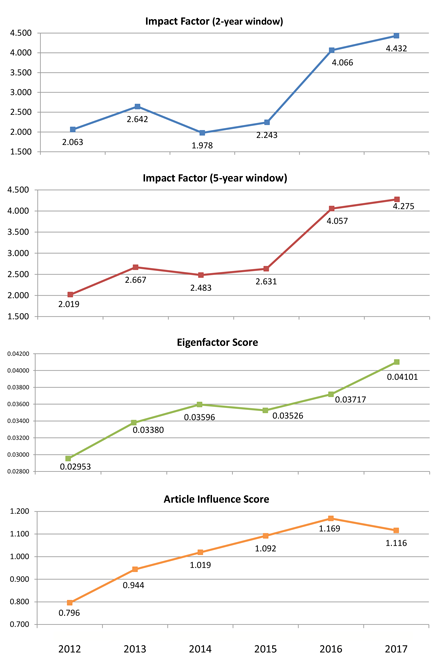|
In my message for this newsletter last year, I was incredibly happy to inform readers of the positive improvement in all relevant metrics for the journal for my first year as Editor-in-Chief. Since then, a lot of work was poured into the publication to reach even greater heights, especially by our editors, reviewers and other special contributors.
And I am thrilled to say that the results of that effort are already noticeable. First and foremost, there was a huge leap in the number of submissions—from 2574 in 2017 to an incredible 3349 in 2018, the highest in all of this journal’s history. I cannot stress enough how this number was beyond our expectations.
This increase shows how TVT has more importance and relevance for authors. We attribute the increased submissions to our high citation metrics, as described in the tables below.
IEEE TVT citation metrics, 2012 –2017

It is clear from the tables that the scores for 2016 are all excellent, but they were even better in 2017—so much improvement in a single year! We have maintained our position in the top quartile in these metrics for telecommunications journals.
Beginning in 2017, we track the Google Scholar h5 index and median for IEEE TVT for each year. In that year, we had a h5-index of 78, which means we had 78 papers in 2013-2017 with at least 78 citations, with a median of 101, which means that those 78 papers had a median of 101 citations.
As a result, we are in sixth place for Computer Networks and Wireless Communication publications in Google Scholar. All of these numbers make me really proud to be at the helm of IEEE TVT, especially because it means good quality is being delivered to our readers, and the recognition for that is notable.
Of course, these results are not my work alone, not by a long shot. I am extremely grateful to our editorial board and reviewers for offering their experience and skills voluntarily to IEEE TVT and working hard to keep up our quality and improve every single day.
Last year I mentioned how happy I was that our turnaround time, the time needed for providing the first editorial decision, was an incredibly low of 2.02 months. Well, to my surprise, both the editor and reviewer teams surpassed themselves once again and in 2018 the turnaround time was of 1.81 months!
This metric is really amazing, especially when the high number of submissions in 2018 is taken into consideration. This results in only 33.2 weeks average between the first submission to publication in IEEE Xplore, which is a short time for all reviews, revisions, and decisions.
Again, thank you to all of our editors and reviewers. We extend special recognition to our 2018 Top Editors
- Sheng Zhong, Nanjing University, China
- Bilal Akin, University of Texas at Dallas, USA
- Yuichi Kawamoto, Tohoku University, Japan
Also, we make a special note to our 2018 Top Reviewers:
- Jie Gao, Ryerson University, Canada
- Vitor Monteiro, University of Minho,, Portugal
- M. Hadi Amini, Carnegie Mellon University, USA
- Fabio Patrone, University of Genoa, Italy
For 2019, we would like to increase our coverage of Autonomous, Connected and Electrical Vehicles. This is a special area for me, and it should grow in importance in the coming years.
As a standard for vehicular technology, IEEE TVT should have representation for these fields of research. With that goal in mind, more editors with particular experience in Autonomous, Connected and Electrical Vehicles have been invited to join our board.
Moreover, special issues in the area are planned for the future, with two of them with publication scheduled for 2019 already. This is a very exciting area with big potential, so I have very high hopes for this project. Thus, I hope 2019 follows the trends of 2017 and 2018, and IEEE TVT can improve once again and even more.
Glossary
Journal impact factor (JIF): index provided by Thomson Reuters’ Institute for Scientific Information (ISI) that measures the number of citations received by manuscripts in a journal.
Eigenfactor score: number that analyzes not only the number of citations but also the sources of the citations, used to evaluate the importance of a journal.
Article Influence Score: number obtained by dividing the Eigenfactor by the number of published papers, essentially giving an average importance score per paper. |